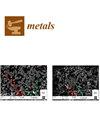1.5 GPa 级回火马氏体钢中球形 θ 沉淀对延迟断裂发生的影响
IF 2.5
3区 材料科学
Q3 MATERIALS SCIENCE, MULTIDISCIPLINARY
引用次数: 0
摘要
本研究旨在阐明球状雪明碳酸盐(θ)析出对 1.5 GPa 级回火马氏体钢发生延迟断裂的影响。使用带阴极电荷的试样进行了恒载试验。对试样施加 1GPa 负载,并在 3% NaCl + 3 g/L NH4SCN 溶液中进行阴极充电。没有球形θ的钢试样在电流密度为 5 A-m-2 甚至增加到 50 A-m-2 时都没有断裂。另一方面,带有球形 θ 的钢试样在 5 A-m-2 电流密度下 0.2 小时后断裂。透射电子反向散射衍射观察到的 30% 轧制后球形 θ 周围的应变表明,就几何必要位错密度而言,球形 θ 周围的局部变形比整个测量区域的变形大 3.05 × 1014 m-2。通过热解吸分析得出的氢解吸曲线显示,轧制 30% 后具有球形 θ 的钢材在 250 °C 附近的氢解吸峰值比不具有球形 θ 的钢材大,250 °C 峰值的活化能值为 109.2 kJ-mol-1。从这些结果推断,250 °C峰是θ/回火马氏体无序界面上的氢。透射电子显微镜观察显示,在延迟断裂面附近的球形 θ 上出现了裂纹和空洞。这些结果表明,球形θ的析出促进了延迟断裂的发生。裂缝似乎是在球形θ周围形成的。本文章由计算机程序翻译,如有差异,请以英文原文为准。
Effect of Spherical θ Precipitation in 1.5 GPa Grade Tempered Martensitic Steel on the Occurrence of Delayed Fracture
The objective of this study is to clarify the effect of spherical cementite (θ) precipitation on the occurrence of delayed fracture in 1.5 GPa grade tempered martensitic steels. Constant load tests were performed with a cathodically charged specimen. A 1GPa-load was applied to the specimen, and cathodic charging was performed in 3% NaCl + 3 g/L NH4SCN solution. The specimen of steel without spherical θ did not fracture at the current density of 5 A·m−2 or even by increasing to 50 A·m−2. On the other hand, the specimen of steel with spherical θ fractured after 0.2 h at 5 A·m−2. The strain around the spherical θ after 30%-rolling observed by transmission electron backscatter diffraction showed that the local deformation around the spherical θ was larger than that in the whole measurement field by 3.05 × 1014 m−2 in terms of geometrically necessary dislocation density. In the hydrogen desorption curve by thermal desorption analysis, steel with spherical θ after 30%-rolling showed a larger hydrogen desorption peak around 250 °C than steel without spherical θ. The value of the activation energy of the 250 °C-peak was 109.2 kJ·mol−1. From these results, the 250 °C-peak is inferred to be hydrogen at the disordered interface of θ/tempered martensite. Transmission electron microscopy observation showed cracks and voids on the spherical θ near the delayed fracture surface. These results indicate that the precipitation of spherical θ facilitates the occurrence of delayed fracture. Cracks appear to form around spherical θ.
求助全文
通过发布文献求助,成功后即可免费获取论文全文。
去求助
来源期刊

Metals
MATERIALS SCIENCE, MULTIDISCIPLINARY-METALLURGY & METALLURGICAL ENGINEERING
CiteScore
4.90
自引率
13.80%
发文量
1832
审稿时长
1.5 months
期刊介绍:
Metals (ISSN 2075-4701) is an open access journal of related scientific research and technology development. It publishes reviews, regular research papers (articles) and short communications. Our aim is to encourage scientists to publish their experimental and theoretical results in as much detail as possible. Therefore, there is no restriction on the length of the papers. The full experimental details must be provided so that the results can be reproduced. Metals provides a forum for publishing papers which advance the in-depth understanding of the relationship between the structure, the properties or the functions of all kinds of metals.
 求助内容:
求助内容: 应助结果提醒方式:
应助结果提醒方式:


